Non-Local Patch Regression Algorithm-Enhanced Differential Photoacoustic Methodology for Highly Sensitive Trace Gas Detection
Abstract
1. Introduction
2. NLPR Algorithm Enhanced DFTIR-PAS Configuration and Theory
2.1. Experimental Setup and System Noise Analysis
2.2. Detection Precision and SNR Enhancement Based on NLPR Denoising
3. Results and Analyses
3.1. Single Target Gas Analysis
3.2. Multi-Component Gas Analysis
4. Conclusions
Author Contributions
Funding
Institutional Review Board Statement
Informed Consent Statement
Data Availability Statement
Acknowledgments
Conflicts of Interest
Appendix A
References
- Wang, J.; Zhang, W.; Liang, L.; Yu, Q. Tunable fiber laser based photoacoustic spectrometer for multi-gas analysis. Sens. Actuators B Chem. 2011, 160, 1268–1272. [Google Scholar] [CrossRef]
- Ismail, B. Tunable double-mode sensor for multi-gas detection based on the external-cavity diode laser. Appl. Opt. 2018, 57, 4039–4042. [Google Scholar]
- Yin, X.; Wu, H.; Dong, L.; Li, B.; Ma, W.; Zhang, L.; Yin, W.; Xiao, L.; Jia, S.; Tittel, F.K. ppb-Level SO2 Photoacoustic Sensors with a Suppressed Absorption–Desorption Effect by Using a 7.41 μm External-Cavity Quantum Cascade Laser. ACS Sens. 2020, 5, 549–556. [Google Scholar] [CrossRef]
- Yin, X.; Dong, L.; Wu, H.; Zheng, H.; Ma, W.; Zhang, L.; Yin, W.; Jia, S.; Tittel, F.K. Sub-ppb nitrogen dioxide detection with a large linear dynamic range by use of a differential photoacoustic cell and a 3.5 W blue multimode diode laser. Sens. Actuators B Chem. 2017, 247, 329–335. [Google Scholar] [CrossRef]
- Chen, K.; Yu, Z.; Gong, Z.; Yu, Q. Lock-in white-light-interferometry-based all-optical photoacoustic spectrometer. Opt. Lett. 2018, 43, 5038–5041. [Google Scholar] [CrossRef]
- Lv, H.; Zheng, H.; Liu, Y.; Yang, Z.; Wu, Q.; Lin, H.; Montano, B.A.Z.; Zhu, W.; Yu, J.; Kan, R.; et al. Radial-cavity quartz-enhanced photoacoustic spectroscopy. Opt. Lett. 2021, 46, 3917. [Google Scholar] [CrossRef]
- Palzer, S. Photoacoustic-Based Gas Sensing: A Review. Sensors 2020, 20, 2745. [Google Scholar] [CrossRef]
- Yin, X.; Dong, L.; Wu, H.; Zhang, L.; Ma, W.; Yin, W.; Xiao, L.; Jia, S.; Tittel, F.K. Highly sensitive photoacoustic multicomponent gas sensor for SF6 decomposition online monitoring. Opt. Express 2019, 27, A224–A234. [Google Scholar] [CrossRef]
- Mao, X.; Zhou, X.; Gong, Z.; Yu, Q. An all-optical photoacoustic spectrometer for multi-gas analysis. Sens. Actuators B Chem. 2016, 232, 251–256. [Google Scholar] [CrossRef]
- Wang, Z.; Chang, J.; Tian, C.; Feng, Y.; Wang, C.; Zhang, H.; Zhang, Q.; Li, H.; Feng, Z.; Zhang, X.; et al. Two-component gas quartz-enhanced photoacoustic spectroscopy sensor based on time-division multiplexing of distributed-feedback laser driver current. Appl. Opt. 2019, 58, 8479–8485. [Google Scholar] [CrossRef]
- Liu, K.; Mei, J.; Zhang, W.; Chen, W.; Gao, X. Multi-resonator photoacoustic spectroscopy. Sens. Actuators B Chem. 2017, 251, 632–636. [Google Scholar] [CrossRef]
- Chen, K.; Liu, S.; Zhang, B.; Gong, Z.; Chen, Y.; Zhang, M.; Deng, H.; Guo, M.; Ma, F.; Zhu, F.; et al. Highly sensitive photoacoustic multi-gas analyzer combined with mid-infrared broadband source and near-infrared laser. Opt. Lasers Eng. 2020, 124, 105844. [Google Scholar] [CrossRef]
- Hirschmann, C.B.; Uotila, J.; Ojala, S.; Tenhunen, J.; Keiski, R.L. Fourier Transform Infrared Photoacoustic Multicomponent Gas Spectroscopy with Optical Cantilever Detection. Appl. Spectrosc. 2010, 64, 293–297. [Google Scholar] [CrossRef]
- Mikkonen, T.; Amiot, C.; Aalto, A.; Patokoski, K.; Genty, G.; Toivonen, J. Broadband cantilever-enhanced photoacoustic spectroscopy in the mid-IR using a supercontinuum. Opt. Lett. 2018, 43, 5094–5097. [Google Scholar] [CrossRef]
- Liu, L.; Mandelis, A.; Huan, H.; Michaelian, K.H. Step-scan differential Fourier transform infrared photoacoustic spectroscopy (DFTIR-PAS): A spectral deconvolution method for weak absorber detection in the presence of strongly overlapping background absorptions. Opt. Lett. 2017, 42, 1424–1427. [Google Scholar] [CrossRef]
- Liu, L.; Huan, H.; Li, W.; Mandelis, A.; Wang, Y.; Zhang, L.; Zhang, X.; Yin, X.; Wu, Y.; Shao, X. Highly sensitive broadband differential infrared photoacoustic spectroscopy with wavelet denoising algorithm for trace gas detection. Photoacoustics 2021, 21, 100228. [Google Scholar] [CrossRef]
- Li, J.; Yu, B.; Zhao, W.; Chen, W. A Review of Signal Enhancement and Noise Reduction Techniques for Tunable Diode Laser Absorption Spectroscopy. Appl. Spectrosc. Rev. 2014, 49, 666–691. [Google Scholar] [CrossRef]
- Zhou, S.; Shen, C.-Y.; Zhang, L.; Liu, N.-W.; He, T.-B.; Yu, B.-L.; Li, J.-S. Dual-optimized adaptive Kalman filtering algorithm based on BP neural network and variance compensation for laser absorption spectroscopy. Opt. Express 2019, 27, 31874–31888. [Google Scholar] [CrossRef]
- Zimmermann, B.; Kohler, A. Optimizing Savitzky–Golay Parameters for Improving Spectral Resolution and Quantification in Infrared Spectroscopy. Appl. Spectrosc. 2013, 67, 892–902. [Google Scholar] [CrossRef]
- Al-Mbaideen, A.A. Application of Moving Average Filter for the Quantitative Analysis of the NIR Spectra. J. Anal. Chem. 2019, 74, 686–692. [Google Scholar] [CrossRef]
- Fan, B.-Q.; Zhang, Y.-J.; He, Y.; You, K.; Li, M.-Q.; Yu, D.-Q.; Xie, H.; Lei, B.-E. Adaptive monostable stochastic resonance for processing UV absorption spectrum of nitric oxide. Opt. Express 2020, 28, 9811–9822. [Google Scholar] [CrossRef]
- Mappe-Fogaing, I.; Joly, L.; Durry, G.; Dumelié, N.; Decarpenterie, T.; Cousin, J.; Parvitte, B.; Zéninari, V. Wavelet Denoising for Infrared Laser Spectroscopy and Gas Detection. Appl. Spectrosc. 2012, 66, 700–710. [Google Scholar] [CrossRef]
- Zheng, C.-T.; Ye, W.-L.; Huang, J.-Q.; Cao, T.-S.; Lv, M.; Dang, J.-M.; Wang, Y.-D. Performance improvement of a near-infrared CH4 detection device using wavelet-denoising-assisted wavelength modulation technique. Sens. Actuators B Chem. 2014, 190, 249–258. [Google Scholar] [CrossRef]
- Li, J.; Yu, B.; Fischer, H. Wavelet Transform Based on the Optimal Wavelet Pairs for Tunable Diode Laser Absorption Spectroscopy Signal Processing. Appl. Spectrosc. 2015, 69, 496–506. [Google Scholar] [CrossRef]
- Li, Y.; Wang, R.; Tittel, F.K.; Ma, Y. Sensitive methane detection based on quartz-enhanced photoacoustic spectroscopy with a high-power diode laser and wavelet filtering. Opt. Lasers Eng. 2020, 132, 106155. [Google Scholar] [CrossRef]
- Chaudhury, K.N. On the Convergence of the IRLS Algorithm in Non-Local Patch Regression. IEEE Signal. Process. Lett. 2013, 20, 815–818. [Google Scholar] [CrossRef][Green Version]
- Buades, A.; Coll, B.; Morel, J.-M. A Review of Image Denoising Algorithms, with a New One. Multiscale Model. Simul. 2005, 4, 490–530. [Google Scholar] [CrossRef]
- Chaudhury, K.N.; Singer, A. Non-Local Euclidean Medians. IEEE Signal. Process. Lett. 2012, 19, 745–748. [Google Scholar] [CrossRef]
- Sun, Z.; Chen, S. Analysis of Non-Local Euclidean Medians and Its Improvement. IEEE Signal. Process. Lett. 2013, 20, 303–306. [Google Scholar] [CrossRef]
- Tounsi, Y.; Kumar, M.; Nassim, A.; Mendoza-Santoyo, F. Speckle noise reduction in digital speckle pattern interferometric fringes by nonlocal means and its related adaptive kernel-based methods. Appl. Opt. 2018, 57, 7681–7690. [Google Scholar] [CrossRef]
- Sattar, F.; Floreby, L.; Salomonsson, G.; Lovstrom, B. Image enhancement based on a nonlinear multiscale method. IEEE Trans. Image Process. 1997, 6, 888–895. [Google Scholar] [CrossRef]
- Tracey, B.H.; Miller, E.L. Nonlocal Means Denoising of ECG Signals. IEEE Trans. Biomed. Eng. 2012, 59, 2383–2386. [Google Scholar] [CrossRef]
- Zhang, B.; Chen, K.; Chen, Y.; Yang, B.; Guo, M.; Deng, H.; Ma, F.; Zhu, F.; Gong, Z.; Peng, W.; et al. High-sensitivity photoacoustic gas detector by employing multi-pass cell and fiber-optic microphone. Opt. Express 2020, 28, 6618–6630. [Google Scholar] [CrossRef]
- Elia, A.; Di Franco, C.; Spagnolo, V.; Lugarà, P.M.; Scamarcio, G. Quantum Cascade Laser-Based Photoacoustic Sensor for Trace Detection of Formaldehyde Gas. Sensors 2009, 9, 2697–2705. [Google Scholar] [CrossRef]
- Li, S.; Wu, H.; Cui, R.; Sampaolo, A.; Patimisco, P.; Spagnolo, V.; Tittel, F.K.; Dong, L. Piezo-enhanced acoustic detection module for mid-infrared trace gas sensing using a grooved quartz tuning fork. Opt. Express 2019, 27, 35267–35278. [Google Scholar] [CrossRef]
- Weigl, S.; Wittmann, E.; Rück, T.; Bierl, R.; Matysik, F.-M. Effects of ambient parameters and cross-sensitivities from O2, CO2 and H2O on the photoacoustic detection of acetone in the UV region. Sens. Actuators B Chem. 2021, 328, 129001. [Google Scholar] [CrossRef]
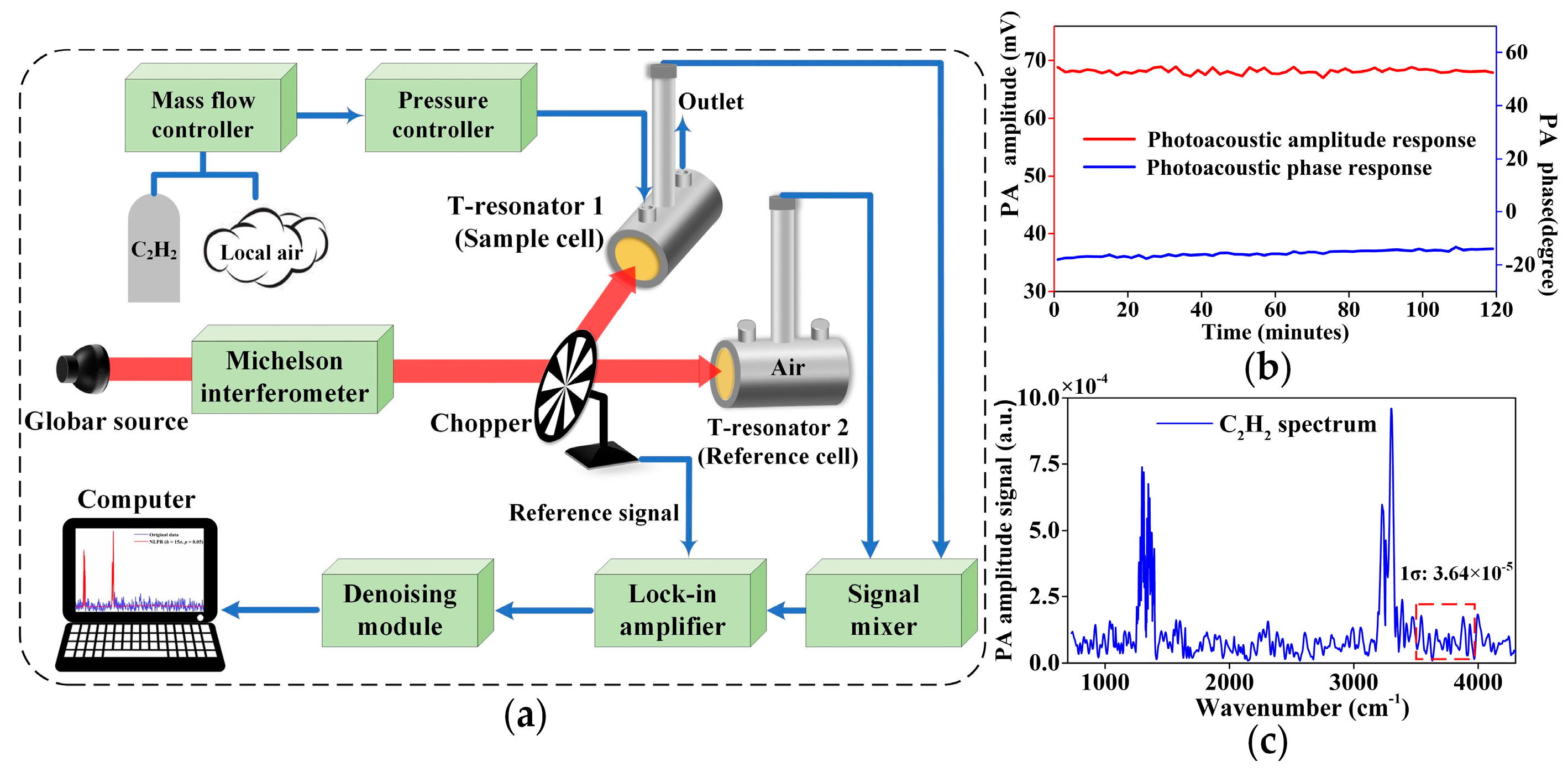


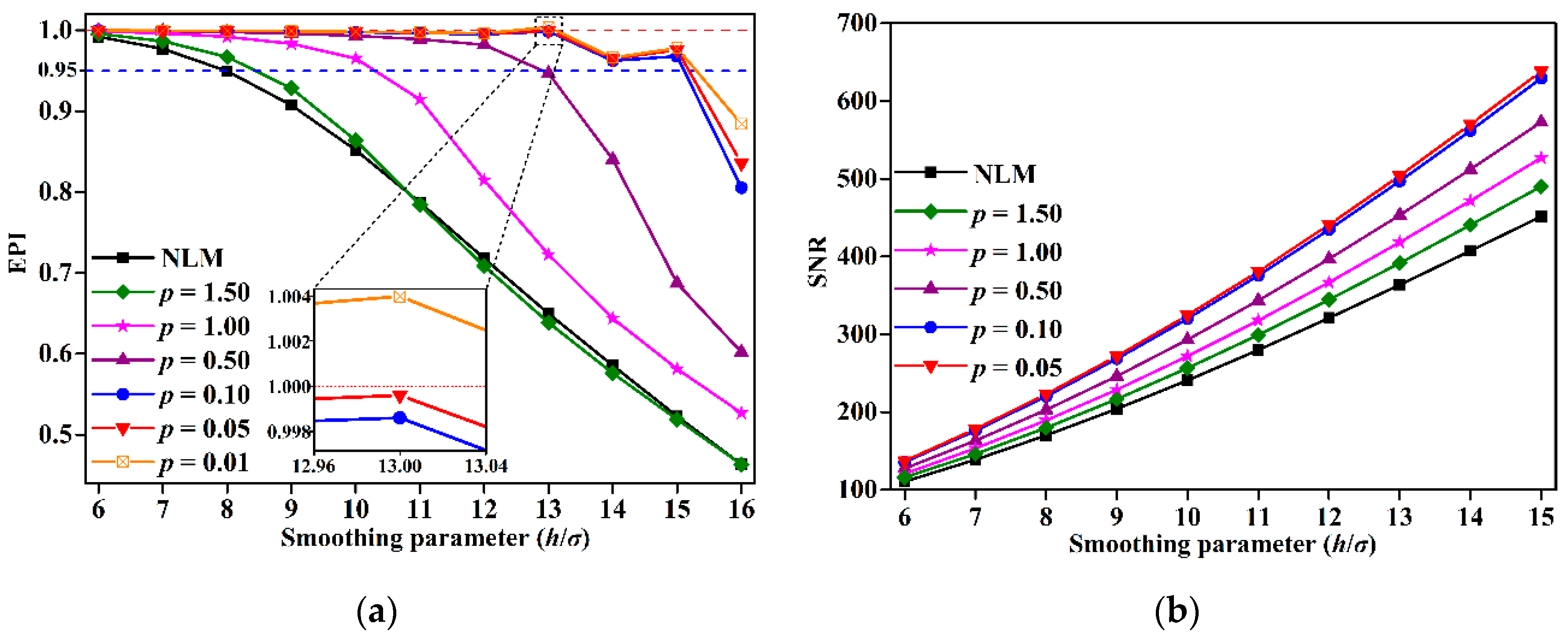

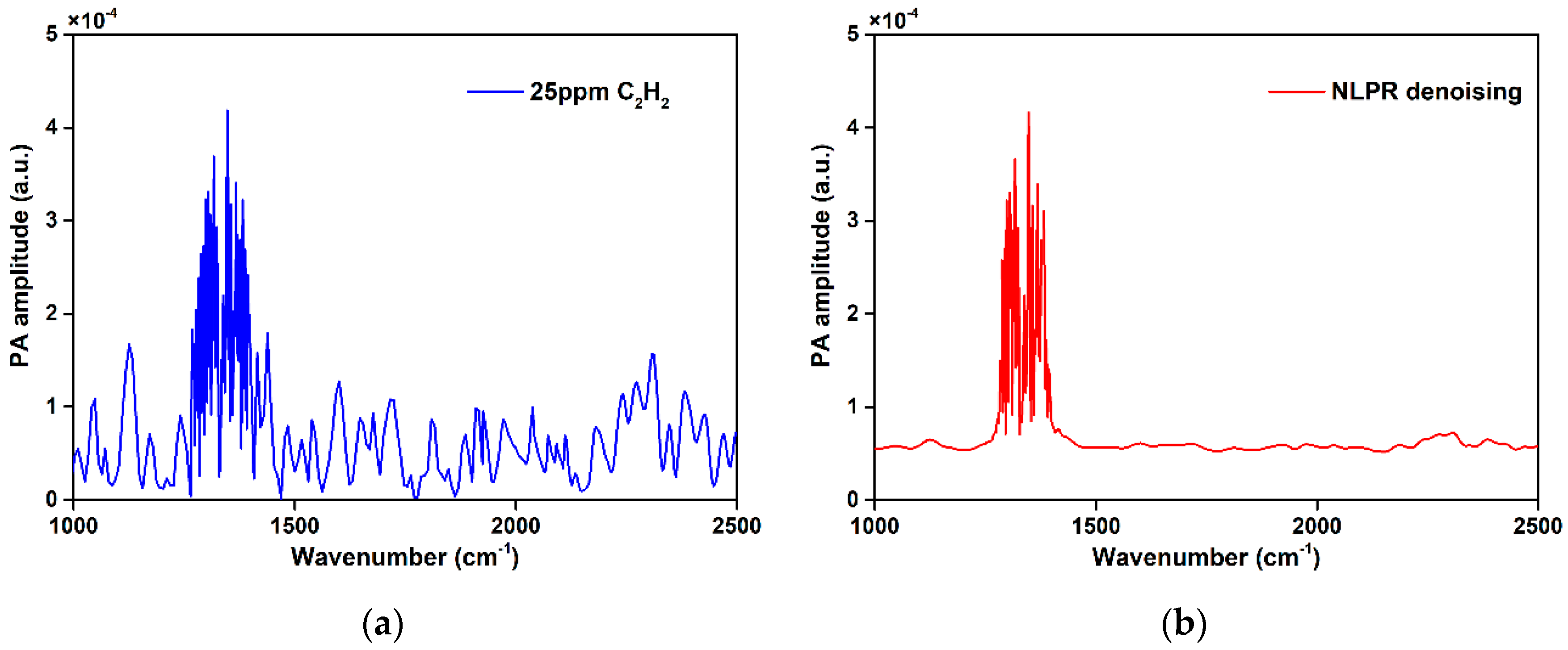
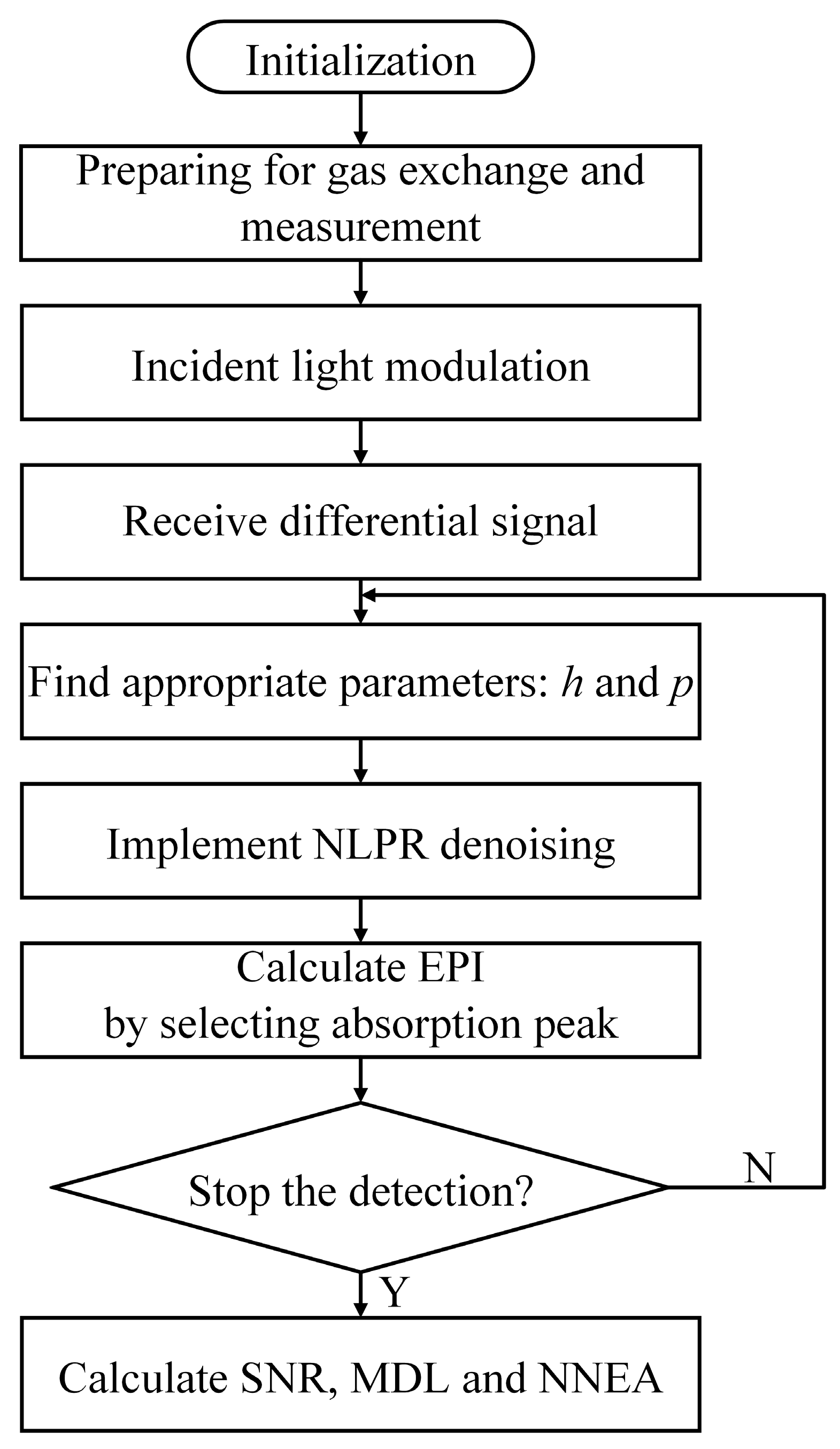
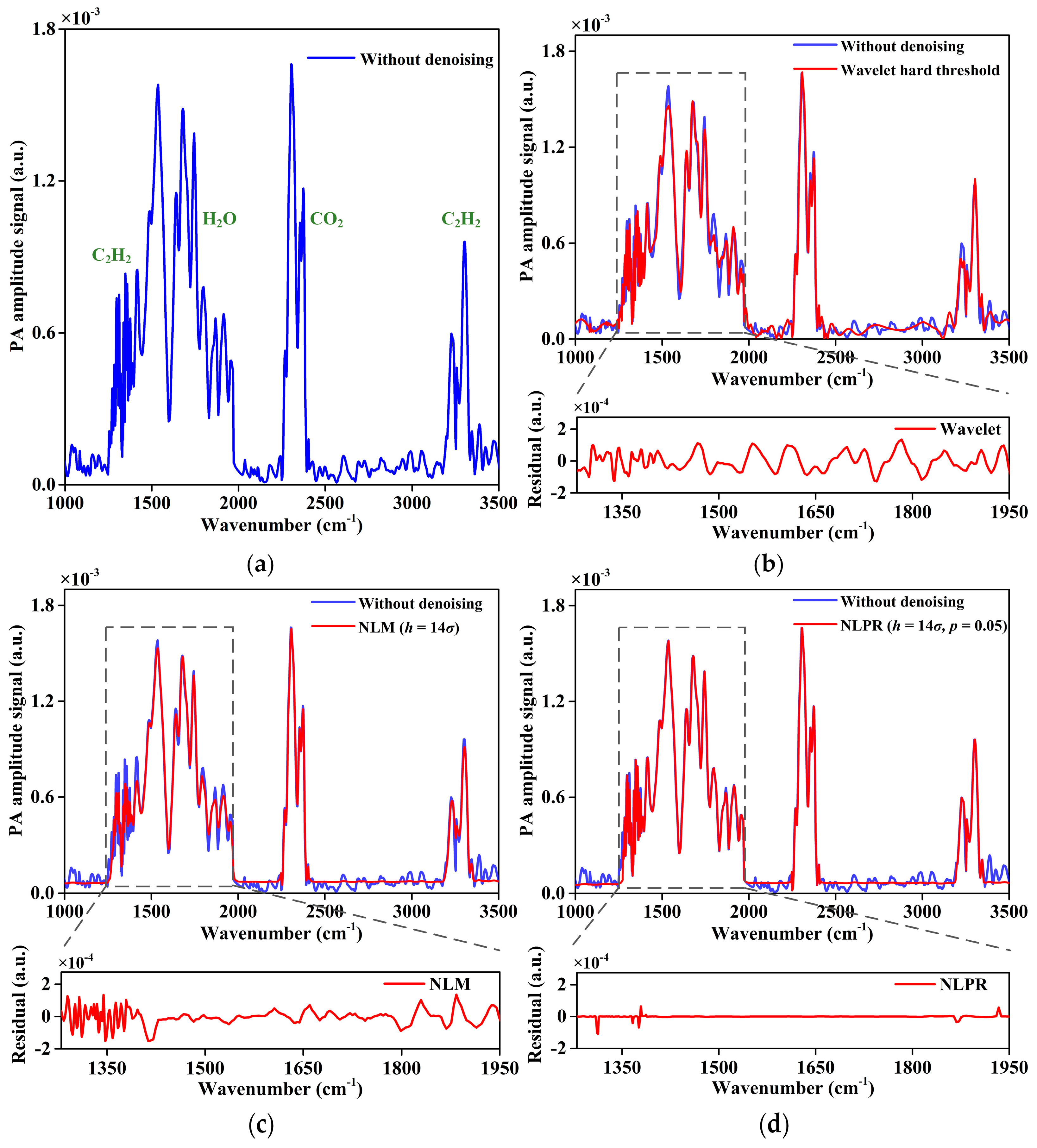
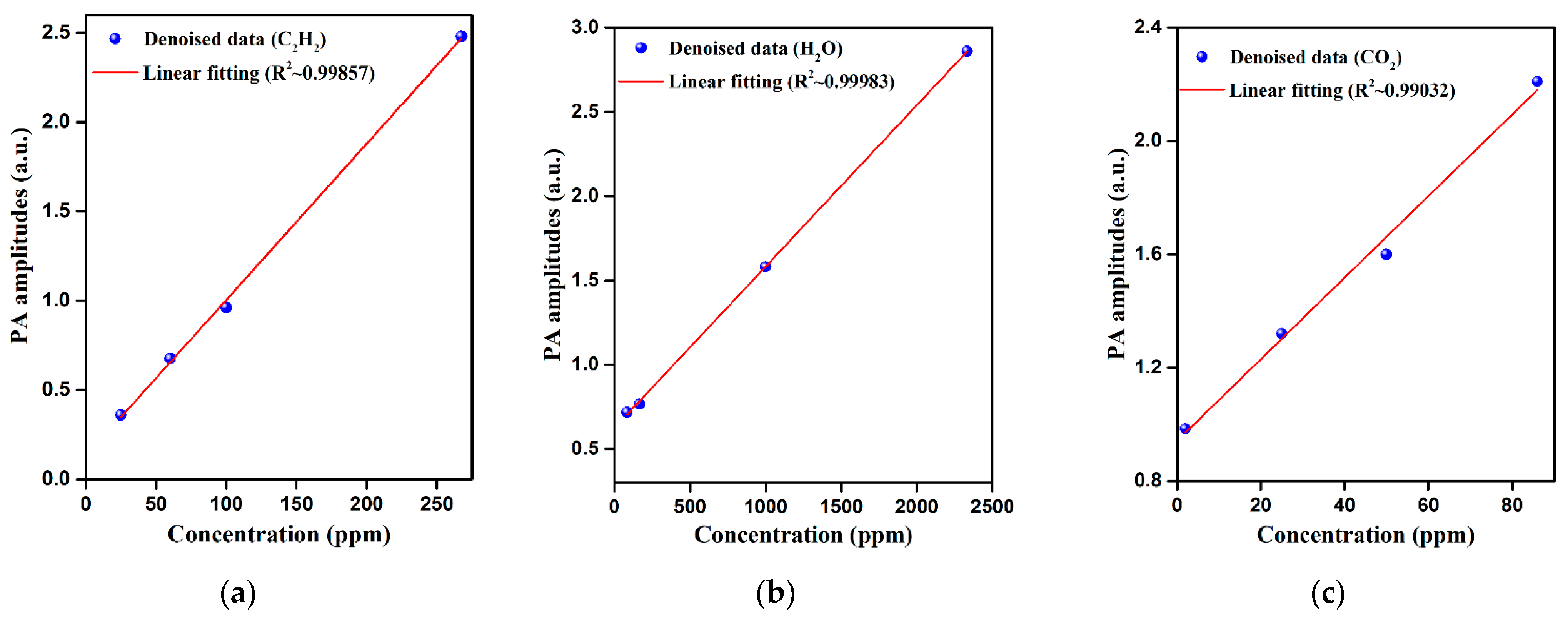
| Algorithm 1. PA Spectrum Signal Denoising Based on NLPR |
|---|
| Input: Noisy differential PA spectrum signal , and parameters Output: Denoised spectrum signal |
| 1 Extend the PA signal by symmetrical padding with the length of P around the boundary points and extract patch of length at every sampling point s. 2 For every sampling point s, the following should be completed: (a) Set for every in the search window. (b) Find a patch with the IRLS method to minimize . (c) Set to be the center point in the patch . |
| Incident Light Intensity (at Target Wavenumber) | Target Gas | NNEA Coefficient (cm−1·W·Hz−1/2) | Reference |
|---|---|---|---|
| 15 mW | C2H2 | 1.4 × 10−9 | [33] |
| 4 mW | CH2O | 2.0 × 10−8 | [34] |
| 1.8 mW | CH4 | 4.1 × 10−9 | [35] |
| 30 μW | C2H2 | 5.50 × 10−11 | This paper |
| Index | Without Denoising | WT | NLM (h = 14σ) | NLPR (h = 14σ) |
|---|---|---|---|---|
| EPI | 1 | 0.9180 | 0.7155 | 0.9599 |
| Noise level | 3.64 × 10−5 | 8.92 × 10−6 | 2.09 × 10−6 | 1.74 × 10−6 |
| SNR improvement factor | - | 3 | 15 | 20 |
Publisher’s Note: MDPI stays neutral with regard to jurisdictional claims in published maps and institutional affiliations. |
© 2021 by the authors. Licensee MDPI, Basel, Switzerland. This article is an open access article distributed under the terms and conditions of the Creative Commons Attribution (CC BY) license (https://creativecommons.org/licenses/by/4.0/).
Share and Cite
Zhang, L.; Liu, L.; Huan, H.; Yin, X.; Zhang, X.; Mandelis, A.; Shao, X. Non-Local Patch Regression Algorithm-Enhanced Differential Photoacoustic Methodology for Highly Sensitive Trace Gas Detection. Chemosensors 2021, 9, 268. https://doi.org/10.3390/chemosensors9090268
Zhang L, Liu L, Huan H, Yin X, Zhang X, Mandelis A, Shao X. Non-Local Patch Regression Algorithm-Enhanced Differential Photoacoustic Methodology for Highly Sensitive Trace Gas Detection. Chemosensors. 2021; 9(9):268. https://doi.org/10.3390/chemosensors9090268
Chicago/Turabian StyleZhang, Le, Lixian Liu, Huiting Huan, Xukun Yin, Xueshi Zhang, Andreas Mandelis, and Xiaopeng Shao. 2021. "Non-Local Patch Regression Algorithm-Enhanced Differential Photoacoustic Methodology for Highly Sensitive Trace Gas Detection" Chemosensors 9, no. 9: 268. https://doi.org/10.3390/chemosensors9090268
APA StyleZhang, L., Liu, L., Huan, H., Yin, X., Zhang, X., Mandelis, A., & Shao, X. (2021). Non-Local Patch Regression Algorithm-Enhanced Differential Photoacoustic Methodology for Highly Sensitive Trace Gas Detection. Chemosensors, 9(9), 268. https://doi.org/10.3390/chemosensors9090268








